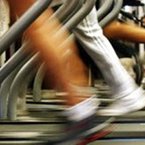
Imagine if you could exercise for only 4 minutes, and receive the same health benefits as you would from spending hours in the gym, on a bike, running, swimming, jumping….Every few months there seems to be another headline promising health benefits from very short periods of exercise, so what’s it all about?
The exercise protocol is called High Intensity Interval Training (HIIT), where you do short bursts of very intense exercise from anywhere between 1 and 4 times a week. HIIT increases insulin sensitivity and VO2 max (an indicator of cardiovascular health), and it really doesn’t take much time to do it at all. With HIIT your cardiovascular health will be better, your insulin sensitivity will improve reducing the risk of diabetes, so you’re likely to live longer.
Is it just me, or is there something weird about wanting to improve your health to live longer, so that you can sit around on your bum doing nothing?
Before we look at HIIT more closely, let’s take a look at some of the benefits of exercise.
Exercise can:
- Improve your mental health by reducing anxiety and alleviating depression
- Improve your balance (important as you age, if you can stay upright, you’re far less likely to facture a hip!)
- Improve or maintain bone strength (after a certain age, you stop laying down bone, but exercising can help you keep more of what you have)
- Improve insulin sensitivity, reducing the risk of diabetes
- Improve your posture
- Improve the range of movement of your joints, keeping you supple
- Improve your musculo-skeletal strength
- Improve you VO2 max, the maximum amount of oxygen you can take up in a minute, considered to be a good indicator of cardiovascular health
- Satisfy a need for making and achieving goals
- Improve self esteem
- Be an outlet for letting off steam in a socially acceptable manner
- Satisfy our desire for competition
- Increase insulin sensitivity
- Make you more able to perform your daily tasks such as hanging out the washing and carrying the shopping
The list is looking pretty long, and it’s certainly not exhaustive. Any three minute exercise regime which can cover all that lot has got to be something pretty special!
High Intensity Interval Training Protocols
HIIT is nothing new, however recent research on this type of exercise is showing some very interesting results, namely, it can improve cardiovascular fitness and increase insulin sensitivity more than some other forms of exercise can.
The Tabata Method
Japanese scientist Dr Izumi Tabata observed the Japanese speed skating team in the early nineties, and noticed that short bursts of brutally hard exercise seemed to be at least as effective as hours of moderate training.
Having spent some time myself in a sport which required this type of training, I certainly agree it was the shorter, harder interval training we did in the latter part of our season, which really sharpened our fitness, and cut down our body fat. We looked forward each year to reaping the benefits of this kind of training, but we didn’t relish having to leave our hearts in the bottom of a surfboat!
There’s no way we could have done this type of training without doing a lot of work to get our bodies ready to handle this. It was the long, less intense rows over winter which allowed us to do the high intensity interval training. Without the build up, the risk of injury would have been too high. Nor could we have had the boat moving as fast. You simply can’t develop efficiency in a sport (including running and speed skating) without spending a fair amount of time focusing on how you do it. So HIIT is great, but as a stand alone training regime, I don’t think it stacks up.
The experiment Tabata conducted took a group of moderately trained students who performed and hour of steady cardiovascular exercise on a stationary bike five times a week. Another group did a 10 minute warm up on the bike and followed with 4 minutes of 20 secs of really hard cycling and 10 seconds rest, four times a week, plus one 30 minute session of steady exercise with two minute intervals.
The results showed large differences in the anaerobic capacity and VO2 max of the two groups. (VO2 max is considered to be an indicator of cardiovascular health) The high intensity group increased their anaerobic capacity by 28%, and their VO2 max by 15%, whilst the control group, who trained for 5 hours each week improved their VO2 max by only 10%, and saw no increase in their anaerobic capacity.
The thing is, you wouldn’t actually expect the steady state group to improve their VO2 max much as they weren’t doing VO2 max specific training, nor training aimed at increasing their anaerobic capacity. It would have been interesting to compare the HIT group with a group who were doing traditional VO2 max training rather than an hour of slower paced riding.
Michael Mosley’s “The Truth About Exercise”
You may have seen the BBC documentary, “The Truth About Exercise”, which had presenter Michael Mosley doing one exercise session a week, within which he did 3 bouts of “all out, leave nothing in the tank” pedalling on a stationary bike for 20 secs, followed by a couple of mins recovery. Add to this, a warm up and a cool down. You can see a good description of the experiment here.
The most interesting result of Mosley’s training was that it greatly increased his insulin sensitivity. Another point made by the program was that his VO2 max, did not improve at all. The researchers said they could predict that as his genes showed that no matter how much exercise he did his “aerobic exercise was unlikely to improve to the same extent as someone whose genes resemble those of an Olympic gold medalist” (you’re kidding me).
Again, you wouldn’t expect this type of training to improve his VO2 max. I’d like to see them put Mosley through a program of specific VO2 max training, and see if he would respond.
So are the claims in the popular media too good to be true?
In a word, YES.
- For a start, it’s not just four minutes of exercise, or three minutes, or whatever protocol it is that you’re following. You definitely need to spend some time warming up and cooling down and stretching, so your four minutes will stretch out to 15 -20 minutes pretty quickly.
- For this type of exercise to be as effective as the research would suggest, you need to go hard, I mean really hard. Even though your total high intensity time is less than three minutes, it’s going to hurt, and a lot of people simply aren’t up for that. I could see myself doing it again if I was competing at a high level in a sport, but I’m not sure I’d like to do it again just for the fun of it.
- You risk injury if you go hard at this type of training too soon. For maximum benefit you need to do some longer less intense stuff to build your body to a point where you can go very very hard.
- You will get some benefits from HIIT by performing a less intense protocol such as that which Michael Mosley followed, and that has to be a good thing .
So what is the best type of exercise?
- The best type of exercise is the exercise you will do, and I guess that’s what a lot of the hype surrounding HIT is about. From the point of view of public health, if people are attracted to exercising because they know that about 10 minutes a week can dramatically improve some aspects of their health, then that’s a good thing. If the alternative is sitting on a couch, for that ten minutes, then HIT is better than nothing. I just don’t get why you’d want to do that.
- It gets back to finding something that you like. Could we start from the premise that people will like exercising, if only they find something they like, rather than assuming people don’t like to exercise? (and just quietly, I wouldn’t be at all surprised to find that someone who leads a sedentary lifestyle doesn’t particularly like high intensity interval training, whether it be for four mins or four seconds-it’s not for everyone)
- I love intense interval training, (though not extreme interval training any more) and I think that most people should be including some kind of more intense interval training in their overall weekly exercise program, but that won’t have you covered for all aspects of your fitness.
- If you like to get out and run on your own to clear your head, do it.
- If you like to swim, swim.
- If you like to work out with other people, join a group.
- If you’re training for a particular event and want to get the best out of your body, include a variety of different training methods, including interval training. Research the best types of training to achieve the results you want, or ask an expert.
- Try something new, dancing, walking –and once a week find a hill and really go hard up and down it five or six times-, pole dancing, take up surfing. Think about the sorts of exercise you did as a kid. Find something that has similar aspects to the exercise you liked doing then.
- To me, exercise is about enjoyment. Enjoying the process, the journey, not just the outcome. So, I’ll stick to my long slow runs, my long runs with a kick thrown in at the end, my resistance training, my high intensity training, my tempo runs.
No, I DON’T enjoy each and every bit of exercise I do, but I never fail to like how it makes me feel afterwards. How about you?
References:
http://www.medicalnewstoday.com/articles/242498.php
http://www.ritsumei.ac.jp/eng/html/research/areas/feat-researchers/interview/izumi_t.html/




No comment yet, add your voice below!
Comments are closed for this article!